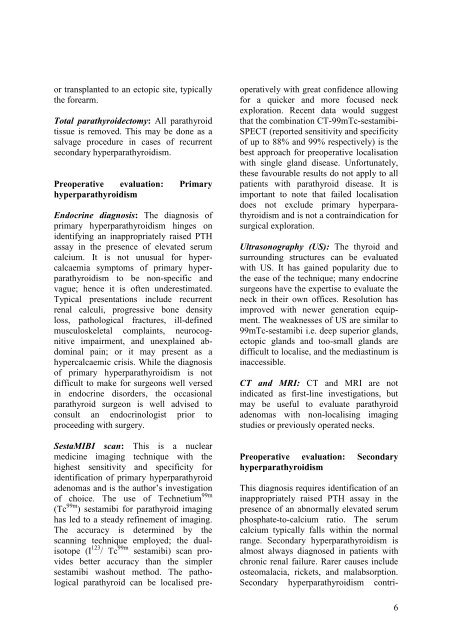Parathyroidectomy - Vula - University of Cape Town
Parathyroidectomy - Vula - University of Cape Town
Parathyroidectomy - Vula - University of Cape Town
You also want an ePaper? Increase the reach of your titles
YUMPU automatically turns print PDFs into web optimized ePapers that Google loves.
or transplanted to an ectopic site, typically<br />
the forearm.<br />
Total parathyroidectomy: All parathyroid<br />
tissue is removed. This may be done as a<br />
salvage procedure in cases <strong>of</strong> recurrent<br />
secondary hyperparathyroidism.<br />
Preoperative evaluation: Primary<br />
hyperparathyroidism<br />
Endocrine diagnosis: The diagnosis <strong>of</strong><br />
primary hyperparathyroidism hinges on<br />
identifying an inappropriately raised PTH<br />
assay in the presence <strong>of</strong> elevated serum<br />
calcium. It is not unusual for hypercalcaemia<br />
symptoms <strong>of</strong> primary hyperparathyroidism<br />
to be non-specific and<br />
vague; hence it is <strong>of</strong>ten underestimated.<br />
Typical presentations include recurrent<br />
renal calculi, progressive bone density<br />
loss, pathological fractures, ill-defined<br />
musculoskeletal complaints, neurocognitive<br />
impairment, and unexplained abdominal<br />
pain; or it may present as a<br />
hypercalcaemic crisis. While the diagnosis<br />
<strong>of</strong> primary hyperparathyroidism is not<br />
difficult to make for surgeons well versed<br />
in endocrine disorders, the occasional<br />
parathyroid surgeon is well advised to<br />
consult an endocrinologist prior to<br />
proceeding with surgery.<br />
SestaMIBI scan: This is a nuclear<br />
medicine imaging technique with the<br />
highest sensitivity and specificity for<br />
identification <strong>of</strong> primary hyperparathyroid<br />
adenomas and is the author’s investigation<br />
<strong>of</strong> choice. The use <strong>of</strong> Technetium 99m<br />
(Tc 99m ) sestamibi for parathyroid imaging<br />
has led to a steady refinement <strong>of</strong> imaging.<br />
The accuracy is determined by the<br />
scanning technique employed; the dualisotope<br />
(I 123 / Tc 99m sestamibi) scan provides<br />
better accuracy than the simpler<br />
sestamibi washout method. The pathological<br />
parathyroid can be localised preoperatively<br />
with great confidence allowing<br />
for a quicker and more focused neck<br />
exploration. Recent data would suggest<br />
that the combination CT-99mTc-sestamibi-<br />
SPECT (reported sensitivity and specificity<br />
<strong>of</strong> up to 88% and 99% respectively) is the<br />
best approach for preoperative localisation<br />
with single gland disease. Unfortunately,<br />
these favourable results do not apply to all<br />
patients with parathyroid disease. It is<br />
important to note that failed localisation<br />
does not exclude primary hyperparathyroidism<br />
and is not a contraindication for<br />
surgical exploration.<br />
Ultrasonography (US): The thyroid and<br />
surrounding structures can be evaluated<br />
with US. It has gained popularity due to<br />
the ease <strong>of</strong> the technique; many endocrine<br />
surgeons have the expertise to evaluate the<br />
neck in their own <strong>of</strong>fices. Resolution has<br />
improved with newer generation equipment.<br />
The weaknesses <strong>of</strong> US are similar to<br />
99mTc-sestamibi i.e. deep superior glands,<br />
ectopic glands and too-small glands are<br />
difficult to localise, and the mediastinum is<br />
inaccessible.<br />
CT and MRI: CT and MRI are not<br />
indicated as first-line investigations, but<br />
may be useful to evaluate parathyroid<br />
adenomas with non-localising imaging<br />
studies or previously operated necks.<br />
Preoperative evaluation: Secondary<br />
hyperparathyroidism<br />
This diagnosis requires identification <strong>of</strong> an<br />
inappropriately raised PTH assay in the<br />
presence <strong>of</strong> an abnormally elevated serum<br />
phosphate-to-calcium ratio. The serum<br />
calcium typically falls within the normal<br />
range. Secondary hyperparathyroidism is<br />
almost always diagnosed in patients with<br />
chronic renal failure. Rarer causes include<br />
osteomalacia, rickets, and malabsorption.<br />
Secondary hyperparathyroidism contri-<br />
6

















